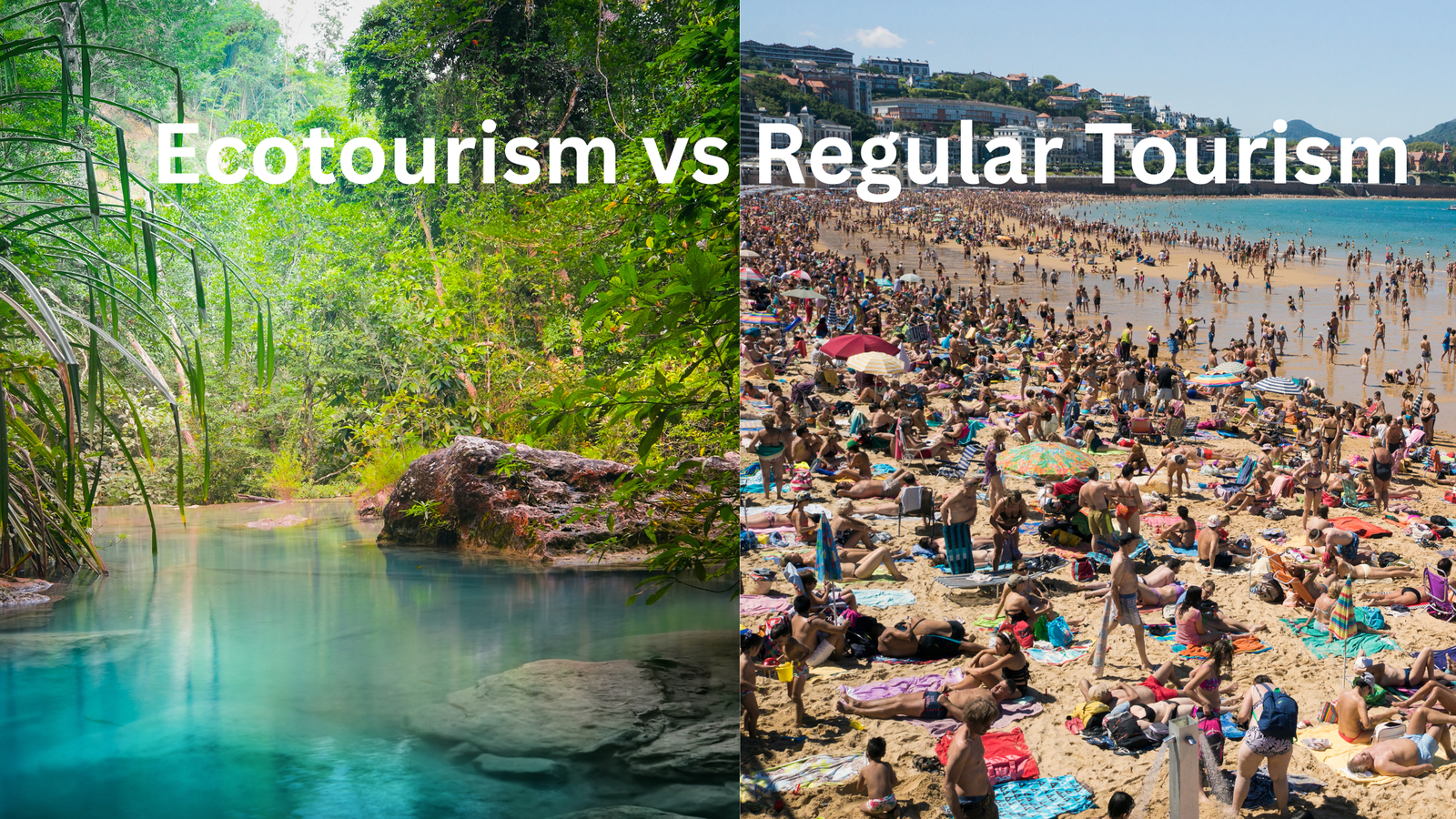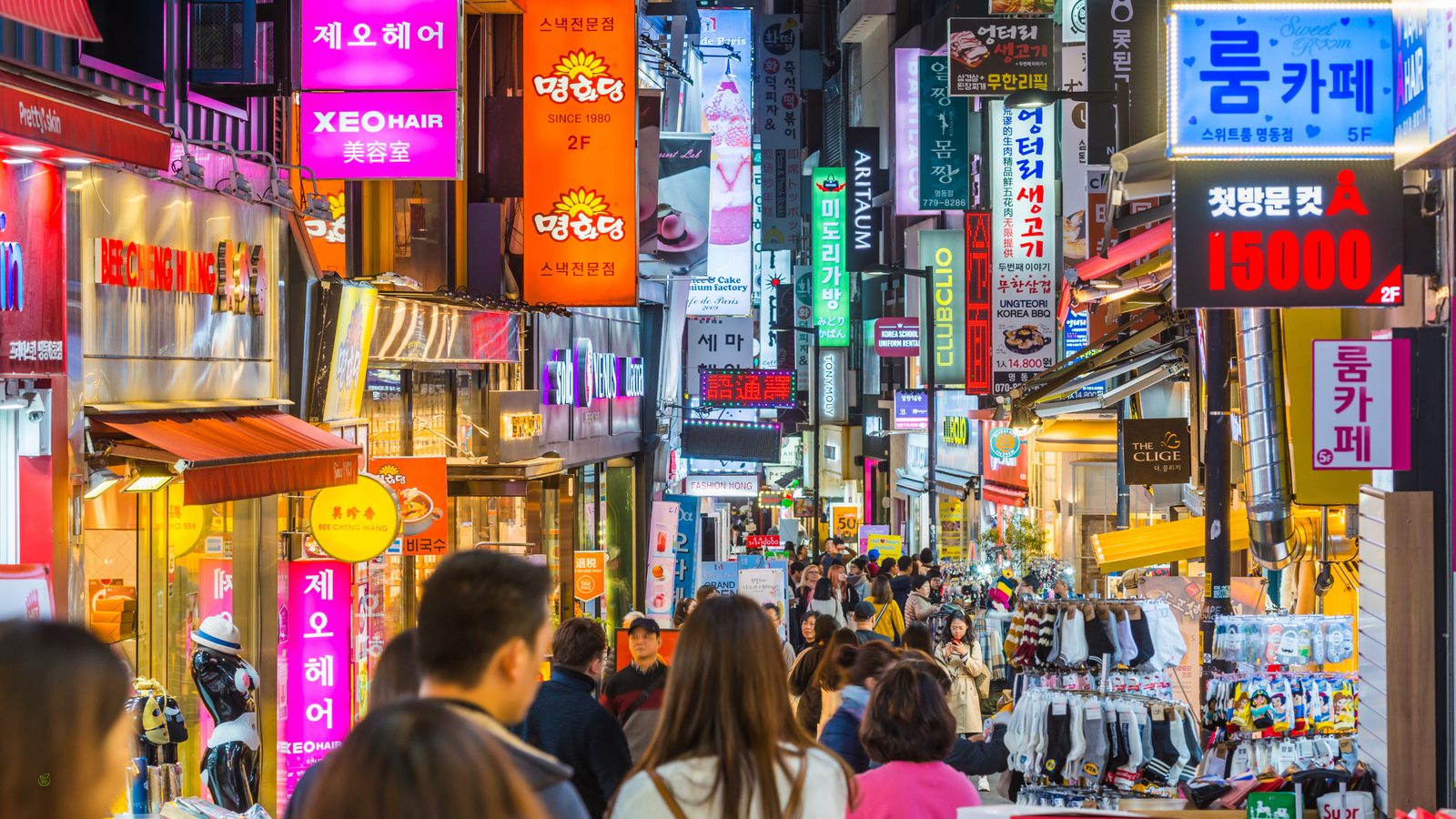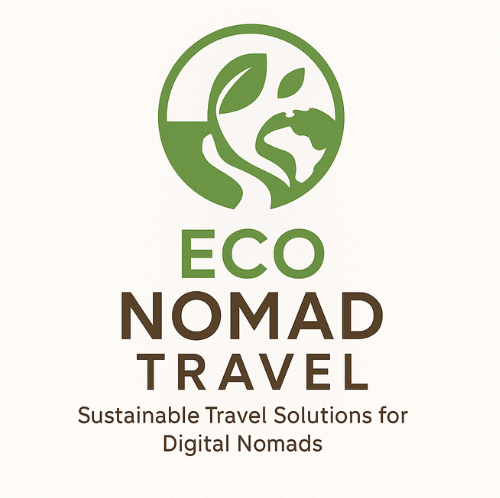Ecotourism vs Regular Tourism (2025): Understanding the Real Difference
Explore how the future of travel is shifting from mass consumption to mindful conservation — and why the difference between regular tourism and ecotourism matters more than ever.

The travel industry is undergoing a quiet revolution. As climate awareness grows, more travelers are rethinking how they move through the world. The contrast between ecotourism and regular tourism is not just about location — it’s about mindset. In this 2025 analysis by Eco Nomad Travel, we unpack how these two approaches diverge in impact, purpose, and ethics.
If you’ve ever wondered what truly separates sustainable exploration from commercial tourism, this guide offers clarity. To go deeper into the philosophy behind this shift, see our full 2025 ecotourism guide.
What Regular Tourism Looks Like
Regular tourism thrives on scale, comfort, and predictability. It’s the traditional model of travel that revolves around convenience — direct flights, packaged resorts, and curated sightseeing. Millions of travelers book these experiences every year because they promise familiarity and efficiency. Yet this same efficiency comes at a cost: local communities rarely see more than a fraction of the profits, and fragile ecosystems are often left degraded.
In 2025, mass tourism still dominates global revenue streams. According to the UN World Tourism Organization (UNWTO), over 70% of international travelers book trips through mainstream providers that rely heavily on centralized infrastructure, fossil-fueled transport, and imported goods. While this boosts GDP in the short term, it typically leads to leakage — when tourism income flows back to foreign corporations rather than staying in the destination itself. In some popular regions, up to 80% of spending leaves the local economy entirely.

The Linear Cost of Leisure: How Traditional Tourism Drains the Planet
Traditional tourism is often linear: visitors arrive, consume, and depart. Resorts import ingredients for buffets, cruise ships discharge waste offshore, and souvenirs are mass-produced overseas. While each act seems small, the cumulative footprint is massive. The aviation industry alone contributes nearly 2.5% of global CO₂ emissions, much of it tied to short leisure trips.
Regular tourism can still be positive when managed well — but its success depends on how much thought goes into limiting resource use and encouraging cultural respect. Without local ownership or environmental standards, even the most stunning destinations risk turning into backdrops rather than living ecosystems. This imbalance explains why cities such as Venice and Bali have introduced visitor caps and eco-taxes to manage overtourism in 2025.
Ultimately, the issue isn’t travel itself. It’s unexamined travel — journeys made without awareness of their ecological or social consequences. Regular tourism, when left unchecked, often extracts more than it gives, leaving destinations less authentic, less diverse, and less sustainable with every season.
What Ecotourism Looks Like
Ecotourism represents a new economic and ethical model for exploration — one that prioritizes ecological balance, cultural preservation, and genuine exchange. Rather than maximizing guest volume, it focuses on minimizing harm and maximizing community benefit. It’s about traveling slowly, respectfully, and purposefully.
At its core, ecotourism integrates three interdependent pillars: environmental conservation, local participation, and education. This means visitors don’t just observe a landscape — they help sustain it. For example, a traveler staying at a Costa Rican eco-lodge might fund native tree planting or purchase meals sourced entirely from nearby farms. In Norway’s fjord villages, electric ferry tours drastically cut marine pollution while funding regional biodiversity projects. These models show that comfort and conscience can coexist.

Ecotourism Goes Mainstream: Data, Transparency, and Digital Accountability
In 2025, data shows that ecotourism is no longer a fringe movement. According to the Global Sustainable Tourism Council, certified eco-operators now account for nearly 15% of international bookings — a 40% increase over five years. This surge is driven by both demand and transparency: travelers increasingly check carbon data, local employment rates, and cultural impact before choosing a tour. Social media has also accelerated accountability, with platforms like TikTok and YouTube showcasing regenerative travel experiences over luxury excess.
What sets ecotourism apart from its conventional counterpart is the feedback loop it creates. The money spent funds reforestation, wildlife protection, and education programs that improve the community’s long-term resilience. Local guides, often trained through conservation NGOs, become ambassadors for biodiversity and cultural storytelling. The result is a tourism economy that not only sustains itself but actively restores what regular tourism has damaged.
Experiencing Ecotourism in Action: Where Sustainability Comes Alive
To experience this firsthand, travelers can explore destinations already redefining sustainability. Visit Costa Rica’s Monteverde Cloud Forest to witness community-run rewilding, kayak Norway’s Lofoten archipelago on electric boats, or hike in Bhutan, the world’s first carbon-negative kingdom. Each of these locations embodies ecotourism’s central philosophy: travel should enrich both the traveler and the place.
To experience this firsthand, travelers can explore destinations already redefining sustainability. Visit Costa Rica’s Monteverde Cloud Forest to witness community-run rewilding, kayak Norway’s Lofoten archipelago on electric boats, or hike in Bhutan, the world’s first carbon-negative kingdom. Each of these locations embodies ecotourism’s central philosophy: travel should enrich both the traveler and the place.
For a broader overview of emerging eco-destinations, explore eco-destinations leading this movement — a curated list blending cultural immersion, biodiversity protection, and digital-nomad accessibility.
Redefining Success: Regeneration Over Revenue
Unlike traditional tourism, ecotourism measures success not by arrivals but by regeneration. Operators often partner with conservation groups, indigenous communities, and carbon-offset projects to ensure their activities have measurable positive outcomes. Explore some of the eco-destinations leading this movement to see the model in action.
The Mindset Shift
The core difference between ecotourism and regular tourism lies in intention. Regular tourism asks, “What can I get from this place?” Ecotourism asks, “What can I give back?” It’s a quiet revolution replacing consumption with connection.
Travelers in 2025 are seeking meaning alongside movement. They choose slower itineraries, public transport, and eco-certified lodging. Many even structure their digital nomad lifestyle around eco-friendly tours that align with their environmental values. The modern traveler isn’t rejecting comfort — they’re redefining it.
Environmental and Social Impact
Regular tourism often leaves behind waste, carbon emissions, and weakened local economies. Ecotourism, by contrast, channels funds into rewilding, education, and small-scale enterprises. In 2025, the industry’s leading operators are measuring not just financial growth but ecological recovery and cultural exchange.
Studies show that for every dollar spent through responsible tourism networks, three to five times more remains in the host community. By supporting local guides, artisans, and farmers, travelers directly strengthen community resilience. To see this philosophy applied at ground level, explore what makes a tour truly sustainable.
The Future of Responsible Travel
As technology and awareness evolve, ecotourism is becoming the blueprint for tomorrow’s travel. AI-powered carbon calculators, electric rail networks, and regenerative lodging are reshaping how we explore. Governments and global initiatives like the Global Sustainable Tourism Council are aligning policy frameworks to reward eco-certified operators.
Travelers are no longer passive consumers; they’re active participants in environmental stewardship. By choosing ecotourism, every journey becomes a vote for a cleaner, fairer planet. It’s not just about where we go — it’s about the footprints we choose to leave behind.
Strengthening Global Standards for Responsible Travel
As responsible tourism grows from niche to norm, a new generation of frameworks now defines how sustainability is measured. The Global Sustainable Tourism Council (GSTC) sets criteria for operators and destinations worldwide, ensuring that eco-labels reflect measurable progress rather than marketing. These criteria evaluate everything from carbon output and biodiversity protection to fair labor and community empowerment. A growing number of tour companies are publicly sharing their carbon audits and impact reports, inviting travelers to see the numbers behind the promise.
According to the World Economic Forum’s latest Travel & Tourism Development Index, the destinations that balance ecological health with social inclusivity outperform competitors on visitor satisfaction and long-term resilience. Nations like Costa Rica, Bhutan, and Slovenia consistently lead because they link tourism to reforestation, local entrepreneurship, and education. Transparency is becoming the new luxury.
Certification bodies such as EarthCheck and Biosphere Tourism are also shifting from static checklists to continuous improvement systems. Their data feeds into global dashboards tracking emissions, waste reduction, and cultural investment, allowing travelers to compare destinations by evidence rather than advertising. This open-data approach is transforming how eco-friendly tours are designed and booked.
Partnering with Local Knowledge
EEAT is not only about linking to institutions — it’s about elevating local expertise. Indigenous communities in Kenya’s conservancies, Norway’s Sami regions, and Peru’s Sacred Valley are integrating traditional land management practices into modern tourism frameworks. By involving these communities directly in certification and storytelling, destinations avoid tokenism and build genuine trust. Responsible travel thrives when knowledge flows both ways: from local to visitor and from traveler back to place.
The Role of the Traveler in 2025
Each traveler now acts as a data point in global sustainability. Choosing a certified operator, offsetting emissions through credible projects, and favoring locally owned accommodations collectively reshape demand curves. Small decisions scale into planetary outcomes. The modern explorer is both participant and protector — measuring footprints not in miles traveled, but in impact left behind.
For deeper context on the origins and evolution of sustainable exploration, see our cornerstone article What Is Ecotourism? The 2025 Guide to Sustainable Exploration. Together, these frameworks and stories illustrate how responsible tourism is becoming the foundation of the global travel economy — not a sidebar to it.
Key Takeaways
- Ecotourism prioritizes conservation, community benefit, and cultural respect.
- Regular tourism prioritizes convenience, speed, and mass appeal — often at ecological cost.
- 2025 travel trends show a surge in data-driven sustainability and regenerative practices.
- Travelers can make a difference by booking certified eco tours and supporting local communities.
Building Long-Term Sustainability in Global Travel
Across the planet, countries are investing in sustainable tourism strategies that balance profit with preservation. From Iceland’s carbon-neutral policies to Costa Rica’s community-led reforestation programs, ecotourism is proving that responsible travel can thrive without sacrificing comfort or adventure. According to the UN World Tourism Organization, destinations that integrate sustainability early experience stronger long-term visitor loyalty and local well-being.
Digital innovation is reinforcing this shift. Platforms like Trip.com and Aviasales are now integrating carbon-tracking features, while eSIM providers such as Airalo and Yesim reduce the waste generated by physical SIM cards. These small technological changes demonstrate how sustainability can be woven into every stage of travel, from planning to arrival.
For readers exploring the ethics of travel deeper, consider visiting our Ecotourism 2025 guide or learning about eco-volunteering and regenerative travel. Together, these resources outline practical paths toward traveling lighter, smarter, and with more respect for the ecosystems we depend on.
Continue Learning
Frequently Asked Questions
Understanding the Basics
What is the main difference between ecotourism and regular tourism?
Ecotourism focuses on conservation, cultural respect, and community empowerment, while regular tourism centers on convenience, comfort, and entertainment — often without considering long-term impact.
Is ecotourism more expensive?
Not always. While certified eco-tours can appear costlier upfront, they often include community reinvestment, sustainable transport, and guided experiences that deliver greater long-term value.
How can travelers identify greenwashing?
Watch for transparency. Authentic operators publish sustainability metrics, hold certifications like GSTC or Travelife, and involve local communities — not just vague “eco” marketing terms.
Can urban tourism be sustainable?
Yes. Cities such as Ljubljana and Singapore now operate renewable transport networks, waste-free markets, and zero-emission zones, proving urban travel can align with sustainability principles.
Does ecotourism really help local economies?
Absolutely. Responsible tourism ensures a larger share of income stays within local communities by supporting guides, artisans, and small enterprises directly.
Deepening the Experience
How do I transition from regular to eco-friendly travel?
Begin by choosing slower travel: stay longer, use trains or buses, and select eco-certified lodges. Even small changes — like offsetting flights or bringing reusable gear — build positive impact.
What role does technology play in sustainable tourism?
AI-powered carbon tracking, blockchain transparency, and apps promoting low-impact routes are redefining how travelers measure and reduce their environmental footprint.
Which destinations lead in ecotourism for 2025?
Top global models include Costa Rica’s rainforest conservation, Bhutan’s carbon-negative policy, and Slovenia’s zero-waste urban tourism framework.
Can digital nomads travel sustainably?
Yes. Choosing renewable-powered co-living spaces, long-stay visas, and digital eSIMs like Airalo and Yesim helps reduce emissions while maintaining global connectivity.
How does ecotourism align with the future of global travel?
It represents the blueprint for tomorrow’s exploration — blending regeneration, inclusion, and data-driven transparency into every journey.
